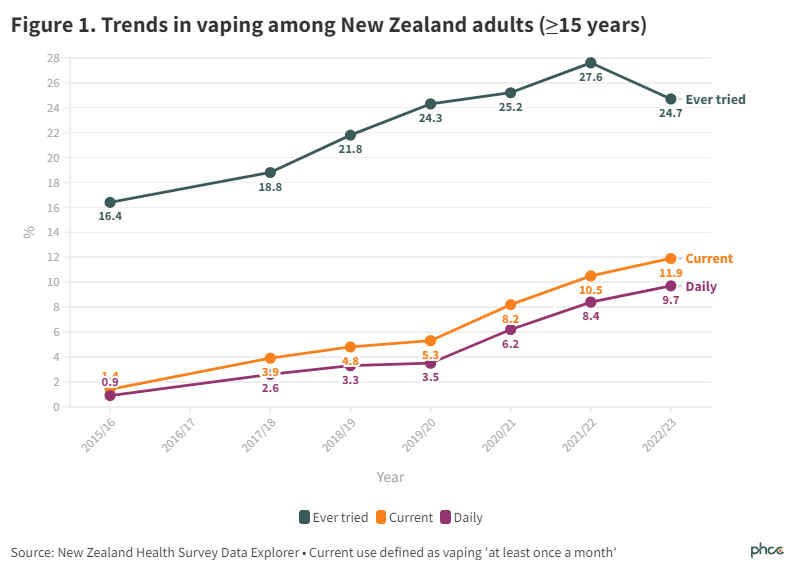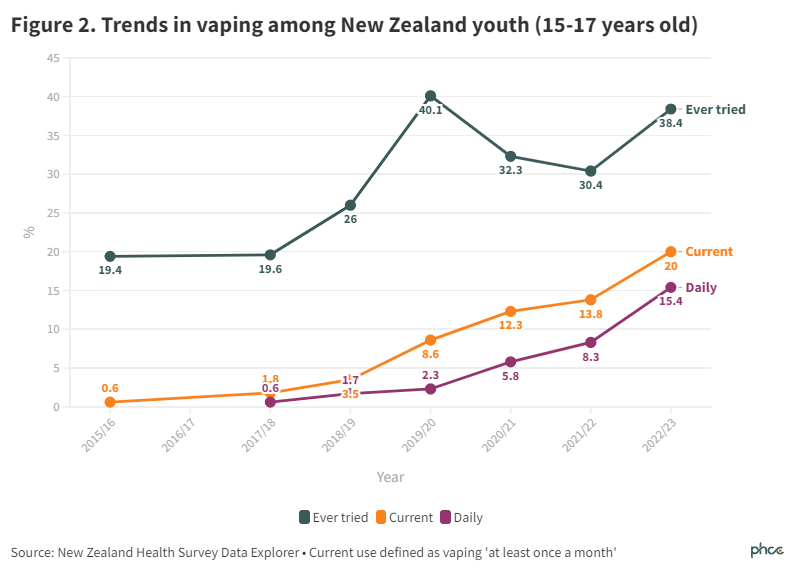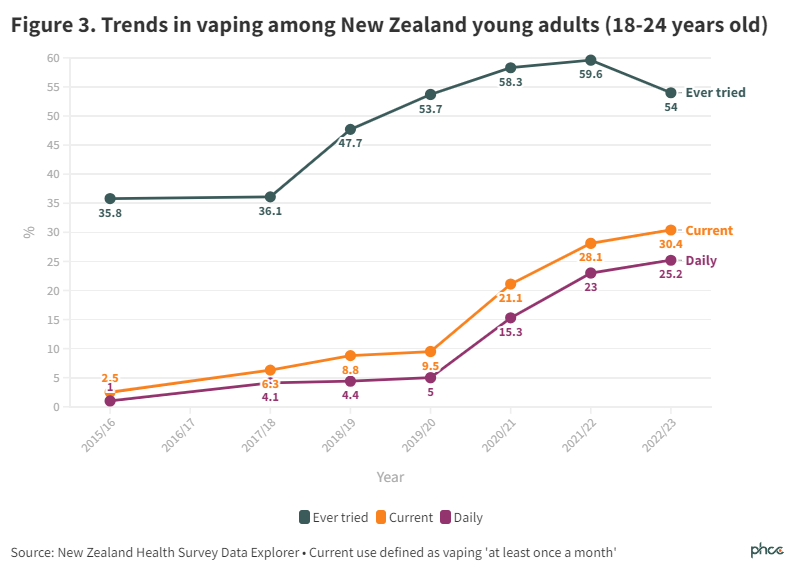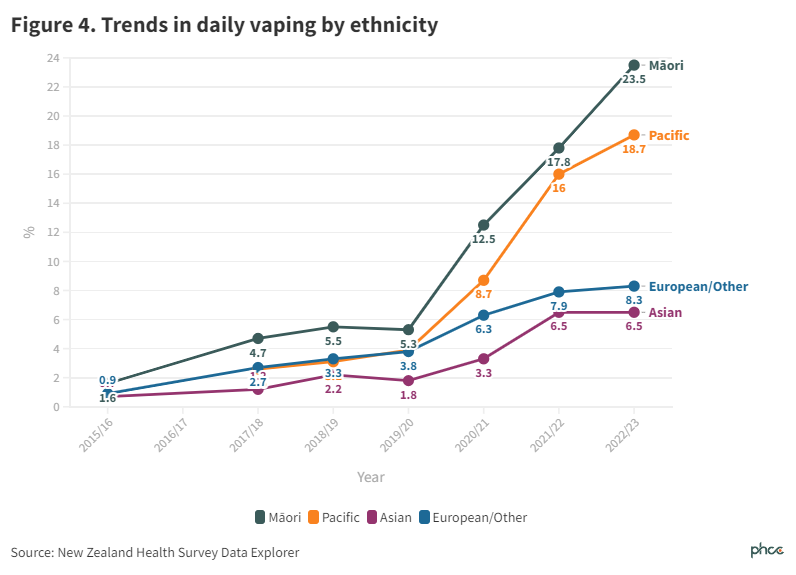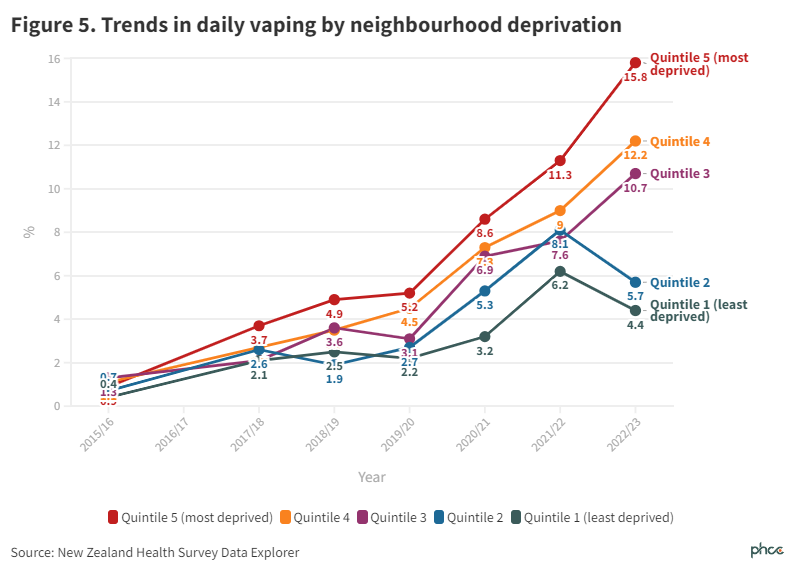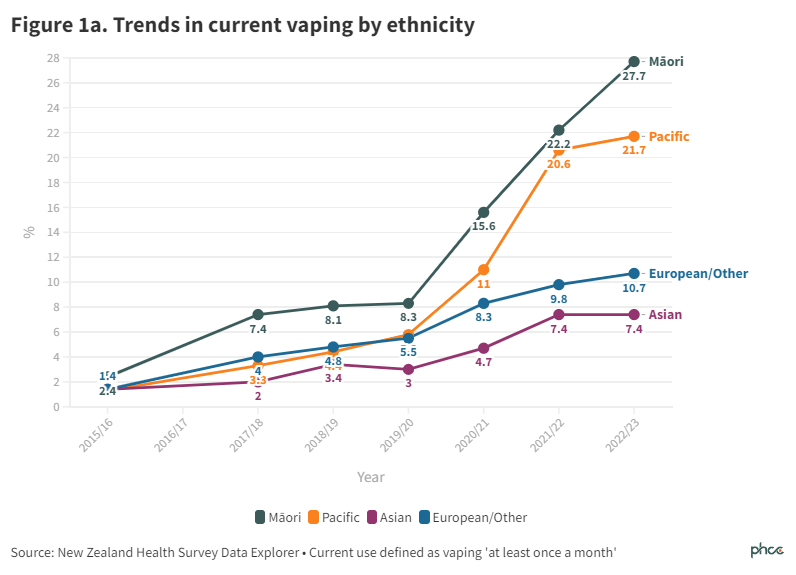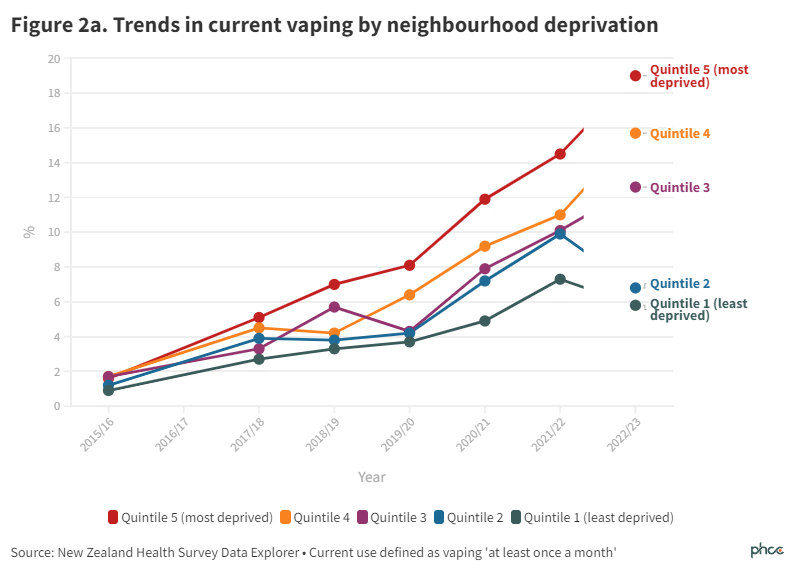Summary
More New Zealanders than ever are vaping according to the latest data from the New Zealand Health Survey released this month. The increase in recent years was particularly marked among younger age groups, Māori and Pacific peoples, and people living in the most deprived neighbourhoods. The findings suggest that the regulatory framework for vaping products needs to be strengthened to minimise youth vaping while also encouraging and supporting older people who smoke to switch to vaping.
E-cigarettes or vaping may help to reduce smoking prevalence as a harm-reduced alternative to smoking for people who smoke and cannot or do not want to quit using nicotine products. However, vaping products can be highly addictive. Despite strengthened regulation of vaping products (see Appendix) recent rapid increases in vaping prevalence among adolescents and young people have created concern among parents, communities, schools, and health workers.
This Briefing summarises key findings on vaping prevalence from the 2022/23 New Zealand Health Survey (NZHS). A previous Briefing provided similar information on smoking prevalence patterns and trends.
About the New Zealand Health Survey
The NZHS is an annual nationally representative population survey. It has run since 2011/12 and aims to sample around 14,000 adults aged 15 years and over every year. Data on vaping prevalence has been collected in each survey since 2015/16 except in the 2016/17 survey. Full details of the methods and a methodology report are available on the Ministry of Health website. Data used in this Briefing are sourced from the NZHS data explorer.
Key findings
Population trends in vaping prevalence
Figure 1 shows recent trends in vaping prevalence in the adult population. Current (at least monthly) and daily vaping prevalence continued to increase in 2022/23, reaching 9.7% (95% confidence interval [CI]: 8.8-10.7%) for daily vaping, representing an estimated 408,000 people.
Vaping prevalence trends among young people
Figures 2 and 3 show trends in vaping prevalence among 15-17 and 18-24 year olds. Daily vaping prevalence among 15-17 year olds almost doubled between 2021/22 and 2022/23 from 8.3% (95%CI: 3.8-15.5%) to 15.4% (95%CI: 10.3-21.9%), representing an estimated 32,000 people in this age group vaping daily.
There was a much more modest increase in daily vaping among 18-24 year olds from 23.0% (95%CI: 16.3-31.0%) in 2021/22 to 25.2% (95%CI: 19.3-31.9%) in 2022/23. One in four 18-24 year olds were estimated to vape daily in 2022/23, around 110,000 people.
Vaping prevalence by ethnicity
Figure 4 shows trends in the distribution of daily vaping by ethnicity (trends in current vaping by ethnicity are shown in Figure 1a in the Appendix below). The increase in daily vaping has been much greater among Māori and Pacific peoples, with almost a quarter of Māori vaping daily in 2022/23. Māori were 2.5 times more likely to vape than non-Māori (adjusted prevalence ratio: 2.54; 95%CI: 2.03-3.18).
Vaping prevalence by neighbourhood deprivation level
Figure 5 shows trends in the distribution of daily vaping by an area-based deprivation measure that is widely used in New Zealand (NZDep). Trends in current vaping by this measure are shown in Figure 2a in the Appendix below. There is a gradient in the degree of increase in daily vaping by level of deprivation, with the greatest increase among people living in the most deprived areas (quintile 5). People living in the most deprived quintiles were 2.8 times more likely to vape than people living in the least deprived quintiles (adjusted prevalence ratio: 2.77; 95%CI: 1.81-4.23).
Patterns of vaping and smoking by age group
Investigating the relationship between changes in vaping and smoking prevalence requires more detailed and sophisticated analyses than is possible within this Briefing. Figure 6 shows an example of how the relationship can be explored by presenting data for daily smoking and vaping prevalence by age group. The chart shows that in 2022/23 vaping was disproportionately concentrated among young people (where smoking prevalence is now low) and indicates that vaping prevalence progressively decreases among older age groups.
Conclusions
The findings suggest that daily vaping prevalence has continued to increase, particularly among youth and young people. The data for 15-17 year olds is especially concerning as sale of vaping products to this age group is illegal in Aotearoa New Zealand. The findings contrast with those of the ASH Year 10 Snapshot survey which found daily vaping prevalence plateaued (albeit at very high levels) for 14-15 year olds in 2023. Vaping prevalence was very high among young adults, with a quarter of 18-24 year olds vaping daily. Vaping is also increasingly concentrated among Māori and Pacific peoples, and people living in more deprived neighbourhoods.
The patterns of daily smoking and vaping prevalence by age groups (Figure 6) suggest: (i) daily vaping among younger age groups is nearly always occurring among non-smokers; and (ii) vaping is currently contributing much less to reducing smoking prevalence among older age groups.
The findings suggest that further substantive measures are required to protect youth and young people from taking up vaping. However, the revised framework should also encourage and support people who smoke, particularly those from older age groups, who cannot or do not want to stop using nicotine products, to switch completely to vaping.
What is new in this Briefing
- The prevalence of current and daily vaping continued to increase in 2022/23, particularly among young people. Prevalence among 15-17 year olds almost doubled from 2021/22.
- Vaping is most prevalent among 15-17 and 18-24 year olds, Māori and Pacific peoples, and people living in the most deprived neighbourhoods. It is less common among older age groups.
Implications for public health practice and policy
- Further measures are required to protect youth and young people from taking up vaping.
- The regulatory framework needs to be strengthened to minimise youth vaping while also allowing access to vaping to support switching to vaping among people who smoke, particularly in older age groups.
Author details
Prof Richard Edwards, Dr Janine Nip, Prof Janet Hoek, Assoc Prof Andrew Waa
All authors are members of ASPIRE Aotearoa and the Department of Public Health, University of Otago, Wellington.
Appendix
Regulation of vaping products
The Smokefree Environments and Regulated Products (Vaping) Amendment Act (November 2020) introduced a new regulatory framework for vaping products to address concerns about lack of control over their marketing and availability. Measures included: (i) introducing specialist and generic retailers, with the latter able to see only a restricted range of vaping products; (ii) requiring all indoor workplaces, including bars and restaurants, to be vape free; (iii) prohibiting most marketing of vaping products other than at the point of sale in specialist retailers; and (iv) prohibiting sale of vaping products to people aged less than 18 years.
Further regulations implemented in September 2023 or to be introduced in December 2023 and March 2024, prevent new specialist vape stores being situated within 300m of schools or a marae and require all single use vaping products to have a removable battery and all vaping products to have a child safety mechanism. In addition, the regulations apply new nicotine concentration limits to single-use vaping products and limit the descriptors that may be used on e-liquids.
Additional results


